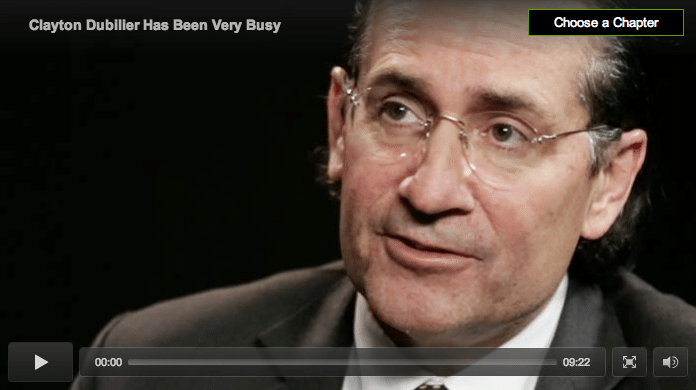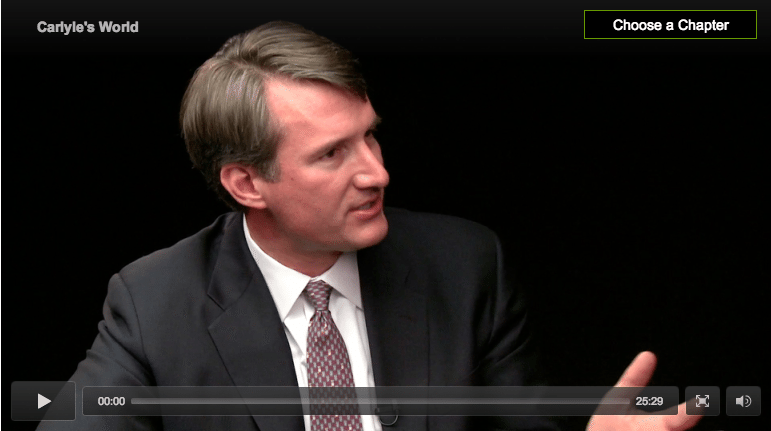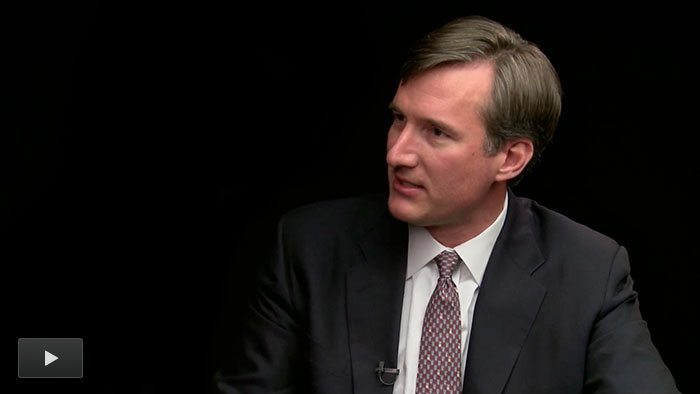Carlyle’s Next Generation
The Carlyle Group started the year with over $170 billion under management and is active everywhere, in virtually every strategy. Glenn Youngkin joined Carlyle in 1995 and is now COO, involved in all the firm’s activities. He offers a firsthand look inside the private equity giant.
Carlyle captures volumes of information from its portfolio companies. What does that data tell you about the state of the world today?
Glenn Youngkin: Let me walk you around the world and tell you what we’re seeing. The United States really had a slowdown in the fourth quarter—surprisingly slow. Our sense is it was caused by all the factors going on in the fourth quarter, from the fiscal cliff negotiations to the election. But what we’ve seen in the first quarter so far is reasonably healthy growth. Not strong growth, but solid. China, interestingly, has really rebounded.
We, of course, saw China slowing more than conventional wisdom—and in the second half of the year particularly. As the leadership transition was undertaken, we watched China rebound. We’re seeing quite strong data out of China today.
South America and the rest of the emerging markets are following suit and will see reasonably strong growth this year. Again, not extraordinary growth, but it will underpin pretty solid global growth.
Europe, in our minds, has stabilized. I wouldn’t say it’s growing, but it’s stopped its decline. Even in the last year, when folks were still very much concerned about Europe’s overall profile, we were seeing real pockets of stabilization.
Our general sense is that global growth will be steady—slow, but steady. And some of the areas where there has been a pretty high level of concern—namely Europe and China—seem to have stabilized, if not really turned around, as China has.
How does that translate into investment opportunity? Do you feel good about putting dollars to work in this environment?
Youngkin: The key question in looking at the overall investment climate is, “Where are the opportunities going to present themselves?” We see a number of factors impacting that. The number-one factor is confidence on behalf of buyers to buy and sellers to sell. One of the hardest things to do when there’s uncertainty around the world is have confidence.
In 2012, we had a very strong investing year. Through September 30, we invested $7.5 billion of equity around the world, which is a very large number, but actually lower than our four- or five-year run rate, which has been about $9 billion a year. We think that’s primarily driven by the fact that there was a lot of uncertainty as to whether the economy was going to recover faster.
A significant amount of our global activity is in China, India, South America, and now Africa and the Middle East. Those markets really need growth, and you need to have confidence that global growth is going to be sustained. We’ve had that confidence. We were investing heavily in those markets in 2010 and beyond. Our sense is that growth is going to be there.
And our sense is it’s going to be a very strong investing year. Capital markets seem to be behaving, the tone is good. The one thing that no one really knows is what’s going to happen in Washington, D.C., over the fiscal cliff, which seems to have an unlimited number of “overtimes”. We need somebody to kick the field goal and put this thing down so the rest of the world can react.
The data that Carlyle gathers from its assets and portfolio companies—you call this the Carlyle Index. What did the index tell you in the dark days of 2009, when many people assumed the world was falling apart?
Youngkin: Almost more important is what it told us during the go-go days of 2007. Midyear 2007 we were worried, really worried. When we looked at the portfolio data and compared it to what we knew was going on in the financing markets in other places, we recognized that some correction had to happen.
So we did two primary things. First, we mandated across our portfolio that people start shoring up, which manifested itself in a number of different ways—from drawing down credit lines to making sure portfolio companies had plenty of cash, to postponing projects. Second, we shored up Carlyle itself to make sure we were prepared. The partners injected capital into the firm. We didn’t need it at the time, but we were worried. Had we not taken some of those actions, we might not have weathered the downturn as well as we did.
Roll the camera forward to 2009. What we began to see in the first half of 2009 was actually life on the shop floor. Order books, inventory levels being drawn down, capital goods being ordered, CEOs coming to us saying, “It’s time for us to expand.” We drew a conclusion in the first half of 2009 that the world was not in dire straits—or not nearly the dire straits that the media portrayed—and really leaned forward. We invested about $5 billion in equity in 2009. We wish we could’ve invested 10, but in a time of massive uncertainty people weren’t going to sell unless they had to. It was a wonderful time to invest if you could find things to invest in.
You’re the chief operating officer of Carlyle; you sit on the operating committee; you’re on the management committee. And so you spend a lot of time with the three founders. Talk about what it’s like to interact with those three and how they interact with each other.
Youngkin: The three of them have distinct responsibilities at Carlyle, and they trust one another in executing those responsibilities. They get together frequently to discuss how things are going, and then they run off and do what their jobs require them to do. Carlyle works the exact same way. They’ve invited people into the firm to help run funds, help run the firm, help deal with our investors, help deal with communications and government affairs, all the different functions. It’s an incredibly liberating environment to work in, because you have founders who aren’t trying to do everything. They’re trying to create capabilities to do everything.
I’ve had the real pleasure of working with these guys now for five years, since I moved out of the investing side into helping them, in 2008, and I’ve never seen them argue. I’ve seen them disagree, but there’s a real respect among the three of them that has permeated the firm. There is a general level of respect in the way people treat one another. We’ve got a culture based on collaboration and respect that is fundamentally driven by those guys.
How does Carlyle process bad news when it comes in?
Youngkin: The way we deal with bad news is to throw resources at it and deal with it. It’s similar to the way we deal with a portfolio company that’s not performing. An investor could be unhappy—which doesn’t happen often—but if an investor’s unhappy, or there’s an economic development somewhere that’s throwing us for a loop, or we have an employee who’s not doing what they’re supposed to be doing, we throw resources at it and we deal with it.
It’s very matter-of-fact. Gather data just like you would an investment decision, talk about it, and make sure you understand what’s going on, what’s the course of action. Then it’s “All right, who’s on point to go take care of it?”
You moved out of the investment side into the leadership of the firm five years ago. To what extent are you still a “deal guy”?
Youngkin: I still get to work with some of our investment teams at the investment-committee level. I primarily work with our South America team, so I still get the chance almost to be on the shop floor as the deals progress, decisions are made, analyzed, approved, and off they go. That keeps my toe in the deal side of things. I also get to oversee corporate development, so when we make an investment into Natural Gas Partners, which we just did in December, I get deeply engaged in that.
Having to deal with all the things that the executives who run our portfolio companies have to deal with has been immensely educational. I have a much more balanced view of the challenges and responsibilities that our portfolio executives have, and also how hard it is to get things done. It’s a lot easier to talk about them in a board meetin-; it’s a lot harder to actually get them done.
What do you say when someone asks you a question that includes the word “succession”?
Youngkin: When I look at Carlyle, I ask the question, “What does Carlyle need to look and feel like in 15 years?” We’re going to need a group of senior people working in a collaborative fashion across a large financial-services firm. Then I look at what we’ve got today. Well, we’ve got a group of senior people working collaboratively across a very large financial-services firm. David, Bill, and Dan have already put in motion a lot of the committee structures, cultural needs, and a group of people to fulfill all these responsibilities down the road.
I don’t think Carlyle’s ever going to have a single CEO. It’s just too big, there are too many responsibilities, and it doesn’t fit the way we work. So the fact that we’ve got a broad management committee, the fact that our founders don’t serve on our operating committee and let the various senior leaders of the firm work, that means we’re on a path toward eventual evolution.
Carlyle is a large organization—not just a large private capital firm, but a large organization. Are there advantages that go with the firm’s size?
Youngkin: Scale matters more than most people might think. It gives us the ability to have a global footprint. We have deep industry teams. We have the financial resources to launch funds. Scale provides all those things.
But it’s balanced with the second big attribute that distinguishes us, which is the way the firm’s constructed. The multifund model counterbalances some of the potential negative factors of scale. It gives our fund teams focus. So our South America team knows that they’re responsible for investing in buyouts and growth capital in South America. They don’t get distracted by trying to do a real estate deal or trying to do a deal in the United States.
The fund construct also enables the firm to scale further. There’s a difference between asking 30 people to run a $5 billion fund and then giving them a $10 billion fund and saying to the same 30 people, “Okay, just do more of what you’ve been doing.” As we grew from $50 billion to $150 billion, the number of funds at work went from 50 to 150. We figured out that the scalability of our model was enhanced by the multifund construct. We could grow our business without overburdening the investment teams.
The third big thing that comes into the mix is people and culture. We’ve been amazingly blessed to attract new people to Carlyle, because a lot of these expansions have been built with people who have been hired from the outside. We’ve been good at bringing in spectacular people who fit the culture—which is the unifying piece. “One Carlyle” is our mantra. It’s our culture, so we don’t get stuck in the silos of each fund, but everybody recognizes that they’re better off if they work together as a group.
That’s resulted in pretty good performance over a long period of time. The combination of the scale and the construct and the people, which are our building blocks, actually results in good outcomes. We don’t always have the best-performing fund, but we’ve been consistently good.
Carlyle is now in a number of businesses. Are there any big opportunities, big investment functions that you have ambitions to add?
Youngkin: I wouldn’t say there are big things that we’re missing. We continue to see investment capabilities that we think could offer unique things to investors—there’s a long list of those.
Next on our list is international energy. We feel that with our infrastructure and power capabilities, commodities capabilities, U.S. oil and gas capabilities, and mezzanine and senior lending in energy, which has broad appeal to investors, has really good opportunity sets in front of it. It offers a pretty unique opportunity. So in the short term, that’s where we’ll probably look. Beyond that, there’s a long list of other things to do, and we just get at ’em one at a time, execute well, and hopefully perform.
Glenn Youngkin on the workings of one of the world’s largest PE firms


